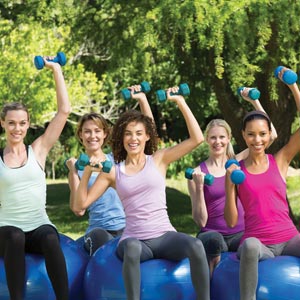Exercising, Decade by Decade

As we age and change, what exercises are appropriate for each decade of our life?
Think of regular exercise as a long-term investment in our overall health and quality of life. It has great benefits, from slowing down the ageing process to keeping our hearts, muscles, and bones strong. Exercise wards off not only many diseases, but it improves the mood, keeping depression and anxiety at bay. Here’s an exercise breakdown for different stages of our life.
Twenties: This is the decade in which any and all intense exercise is best unless there are some physical limitations. Unfortunately this is also the decade when most people don’t exercise as they feel that they are young and don’t need to be concerned with it. However, this is the prime time to establish a good exercise program whether it’s playing sports, group fitness classes, circuit training or strength training workouts. The choice is yours!
Thirties: The thirties pose a challenging time for both men and women as they are building careers and starting a family. It is important to begin some physical activity in this age if not started already. For both sexes, this is the prime time to build muscle and begin a strength training program. Intense group fitness classes that combine resistance training and cardio moves in a single class are a great choice. Additionally, activities such as running, biking, and jogging that keep the heart strong are all recommended. For women, fitness can be started or maintained through prenatal and postnatal group fitness classes before, during and after pregnancies.
Forties: In the forties, our bone mass declines and metabolism begins to slow down. This is also the beginning of certain diseases such as diabetes, high blood pressure, cardiovascular disease. However, this is also a great time to begin an exercise program and build up incredible fitness. Many have won marathons and competitions during this decade. Begin slowly with activities such as walking, jogging, and biking and gradually improve. Strength training for both men and women is equally important at this time due to loss of muscle mass in this decade. Strength training performed two to three times a week will keep the metabolism revved up, burning extra calories and keeping weight gain at bay. Instead of going to the same exercise class, add a variety of exercises such as resistance training, cardiovascular exercises, and stretching for flexibility. For women, the late 40s is a time of fluctuating hormones and weight gain. A combination of weight lifting, cardio and yoga workouts are best and if maintained will definitely pay off in the later decades.
Fifties: Exercise in the fifties should become high priority. Any exercise that was begun earlier and successfully maintained can be continued in this decade, however, with caution. For women, there is increased loss of bone density due to menopause. Muscle loss increases along with weakening joints and there is an increase in weight gain due to hormonal changes. Strength training exercises are very important to perform in this decade to prevent loss of muscle mass for both men and women. These exercises should be performed under the supervision of a qualified trainer to avoid injury. Daily walking, biking, elliptical machine workouts are good choices for cardiovascular fitness. These exercises can also offset aging related health issues for both men and women and can make activities of daily living manageable in future decades.
Sixties, seventies and beyond: Aches and pains may creep up during these decades along with a further increase in muscle loss and fatigue which can prevent exercise. However, regular exercise is still crucial. The risk of falling is high in these decades so balance exercises are important. Brisk walking, Tai-chi, swimming, and strength training are all good exercises in these decades. Regular exercise also prevents dementia which can be of concern.
[Aarti Patel serves as the columnist for Fitness Lifestyle. She has a B.Sc. in Health Information Administration and is certified by the American Council on Exercise as a Personal and Group Fitness Instructor, and Lifestyle and Weight Management Coach. She can be reached at (404)-376-5655; info@aartifitness.com. This column rotates monthly along with the Ask the Doctor column by Gulshan Harjee, M.D.]
Enjoyed reading Khabar magazine? Subscribe to Khabar and get a full digital copy of this Indian-American community magazine.
blog comments powered by Disqus










